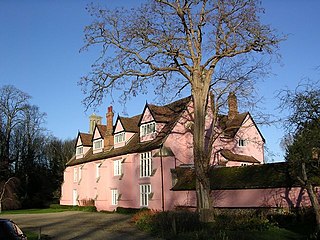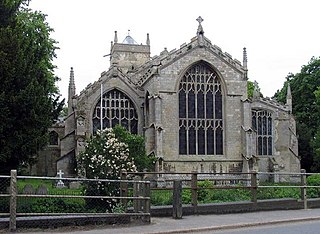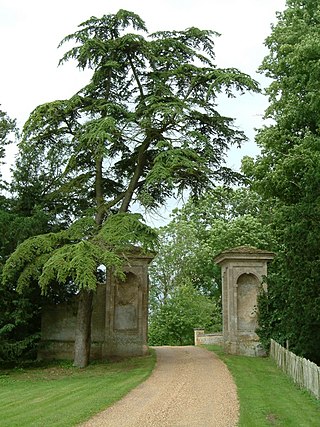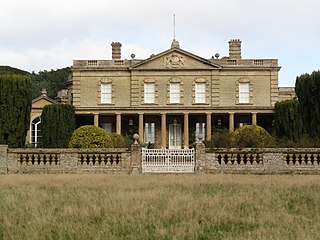Related Research Articles

Battle Abbey is a partially ruined Benedictine abbey in Battle, East Sussex, England. The abbey was built on the site of the Battle of Hastings and dedicated to St Martin of Tours. It is a Scheduled Monument.

St Benet's Abbey, also known as St Benet's at Holme or St Benet Hulme, was a medieval monastery of the Order of Saint Benedict situated at Cow Holm in Horning, Norfolk, England. It lay on the River Bure within the Broads. St Benet is a medieval English version of the name of St Benedict of Nursia, hailed as the founder of western monasticism. At the period of the Dissolution of the Monasteries the abbey's possessions were in effect seized by the crown and assigned to the diocese of Norwich. Though the monastery was supposed to continue as a community, within a few years at least the monks had dispersed. Today there remain only ruins.

Wymondham Abbey is the Anglican parish church for the town of Wymondham in Norfolk, England.

The London Charterhouse is a historic complex of buildings in Clerkenwell, London, dating to the 14th century. It occupies land to the north of Charterhouse Square, and lies within the London Borough of Islington. It was originally built a Carthusian priory, founded in 1371 on the site of a Black Death burial ground. Following the priory's dissolution in 1537, it was rebuilt from 1545 onwards to become one of the great courtyard houses of Tudor London. In 1611, the property was bought by Thomas Sutton, a businessman and "the wealthiest commoner in England", who established a school for the young and an almshouse for the old. The almshouse remains in occupation today, while the school was re-located in 1872 to Godalming, Surrey.

Billingford is a village and civil parish in the Breckland district of Norfolk, England, about 3+1⁄2 miles (5.6 km) north of East Dereham. The village is just north of the River Wensum, which forms the southern boundary of the parish. The village is on the B1145 road, which links King's Lynn and Mundesley. The 2011 Census recorded the parish population as 253.

Thetford Priory is a Cluniac monastic house in Thetford, Norfolk, England. Founded in 1103 by Roger Bigod of Norfolk, Thetford was one of the most important monasteries of East Anglia.
St Mary's Abbey, also known as Malling Abbey, is an abbey of Anglican Benedictine nuns located in West Malling, Kent, England. It was founded around 1090 by Gundulf, Bishop of Rochester and dissolved in 1538. The site became a monastery again in the late 19th century.

Clare Priory is a religious house in England, originally established in 1248 as the first house of the Augustinian Friars in England. It is situated on the banks of the River Stour, a short distance away from the medieval village of Clare, Suffolk. The friary was suppressed in 1538 and the property passed through many hands until it was again purchased by the Augustinian friars in 1953. Today the Priory offers modern retreat facilities for guests.

Walsingham Priory was a monastery of Augustinian Canons regular in Walsingham, Norfolk, England seized by the crown at the Dissolution of the Monasteries under King Henry VIII.

Sibton Abbey, an early Cistercian abbey located near Yoxford, Suffolk, was founded about 1150 by William de Chesney, High Sheriff of Norfolk and Suffolk. A sister house of Warden Abbey, near Bedford, Bedfordshire, Sibton Abbey was the only Cistercian abbey in East Anglia. It was dissolved in 1536.

Outwell is a village and civil parish in the borough of King's Lynn and West Norfolk, in the English county of Norfolk.
Povington Priory was a Benedictine priory in Tyneham, Dorset, England.

Pentney Priory was an Augustinian priory at Pentney in the district of King's Lynn and West Norfolk, Norfolk, England. The ruins of the priory, mostly comprising the flint-built gatehouse, are Grade I listed.
Walsingham Friary was a Franciscan friary at Walsingham, Norfolk, England. It was founded in 1347 and suppressed in the 16th century in the Dissolution of the Monasteries.

West Dereham Abbey was an abbey in Norfolk, England.

Lutton is a village and civil parish in the South Holland district of Lincolnshire, England. The population of the civil parish at the 2011 census was 1,261. It is situated about 4 miles (6 km) north-east from the town of Holbeach. The village has been known by the alternative name of Sutton St Nicholas. The civil parish comprises the village of Lutton, with Lutton Marsh to the north-east and Lutton Garnsgate to the south-west.

Gunton Hall, Gunton Park, is a large country house near Suffield in Norfolk.

Billingford or Pirleston is a village and former civil parish, 19 miles (31 km) south of Norwich, now in the parish of Scole, in the South Norfolk district, in the county of Norfolk, England. In 1931 the parish had a population of 150.
Slevesholm Priory was a Cluniac priory in the civil parish of Methwold, Norfolk, England, that was dedicated to St. Mary and St. Giles. A cell of the Castle Acre Priory, Slevesholm Priory was either granted by William de Warenne, 5th Earl of Surrey between 1222-6 or established during the reign of king Stephen (1135–1154), and dissolved in 1537 during the dissolution of the monasteries. There are no extant remains of the priory; Historic England undertook field research in 1976 and remarked: "There are no physical remains of this [priory] at the formerly published site which is now under plough; farm workers questioned had no knowledge of early finds or foundations. [There is] impression of early quarrying [while] no recognisable pattern is evident and there is no surface trace of building material."
References
- ↑ "Beck Hall - Billingford - Norfolk - England". British Listed Buildings. 4 December 1951. Retrieved 2 June 2016.
- ↑ Index monasticus; or the abbeys and other monasteries, alien priories... Richard Taylor
- ↑ Seals By Walter de Gray Birch; Bec, Billingford, Norfolk.
- ↑ "Hospitals: Beck | British History Online". British-history.ac.uk. Retrieved 2 June 2016.
- ↑ Humanistiska vetenskaps-samfundet; Lund, Louise Vinge C.W.K. Gleerup. vol. 72-74 p. 22
- ↑ The Visitation of Norfolk 1563 & 1613 edited by Walter Rye, London 1891, p.91.